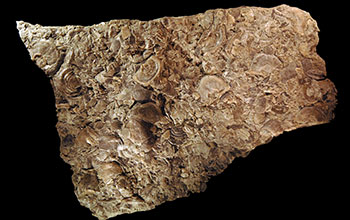Multimedia Gallery
Slab of fossiliferous Late Ordovician limestone from Cincinnati, Ohio
A slab of fossiliferous, Late Ordovician limestone from the Cincinnati, Ohio, region. Many of the shelly brachipod fossils on this slab belong to species that invaded the Cincinnati region during the Richmondian Invasion--an episode of intense invasion preserved in the Late Ordovician strata of the Cincinnati region.
A study by researchers at Ohio University took a closer look at a dramatic ecological shift captured in the fossil record during the Ordovician period, about 450 million years ago. They found that major geological developments triggered evolutionary changes in the ancient seas, which were dominated by organisms such as brachiopods, corals, trilobites and crinoids.
During this period, North America was part of an ancient continent called Laurentia that sat near the equator and had a tropical climate. But shifting tectonic plates gave rise to the Taconic Mountains--forerunners of the Appalachian Mountains--leaving a depression behind the mountain range and flooding the area with cool water from the surrounding deep ocean, bringing an influx of invasive species. The Ohio scientists questioned where the invaders came from and how they managed to get a foothold in the ecosystem.
To examine how individual speciation events occurred, the researchers created several phylogenies--or trees of reconstructed evolutionary relationships--using the fossils of 53 species of brachiopods that dominated the Laurentian ecosystem. The invaders that proliferated during this time period were species within the groups of animals that inhabited Laurentia. Within the brachiopods, corals and cephalopods, for example, some species were invasive and some were not.
The researchers found that over the course of a million years, two patterns of survival emerged as geological changes slowly played out. During the early stage of mountain building and ocean cooling, the native organisms became geographically divided, slowly evolving into different species suited for these niche habitats. This process, called vicariance, is the typical method by which new species originate on Earth.
As the geological changes progressed, however, species from other regions of the continent began to directly invade habitats, a process called dispersal. Although biodiversity may initially increase, this process decreases biodiversity in the long-term because it allows a few aggressive species to populate many sites quickly, dominating those ecosystems.
"Only one out of 10 invaders truly become invasive species. Understanding the process can help determine where to put conservation resources," said Alycia Stigall, an Ohio University associate professor of geological sciences who co-authored a paper on the study.
The study was funded in part by National Science Foundation (NSF) grant EAR 09-22067.
To learn more about this research, see the NSF News From the Field story Rising mountains, cooling oceans prompted spread of invasive species 450 million years ago, study finds. To learn more about the species that lived in the Cincinnati region during the Richmondian Invasion, see the Digital Atlas of Ordovician Life, which is supported by NSF grants EF 12-06750 and EAR 09-22067. (Date of Image: March 2011)
Credit: Alycia L. Stigall, Ohio University
See other images like this on your iPhone or iPad download NSF Science Zone on the Apple App Store.
Images and other media in the National Science Foundation Multimedia Gallery are available for use in print and electronic material by NSF employees, members of the media, university staff, teachers and the general public. All media in the gallery are intended for personal, educational and nonprofit/non-commercial use only.
Images credited to the National Science Foundation, a federal agency, are in the public domain. The images were created by employees of the United States Government as part of their official duties or prepared by contractors as "works for hire" for NSF. You may freely use NSF-credited images and, at your discretion, credit NSF with a "Courtesy: National Science Foundation" notation.
Additional information about general usage can be found in Conditions.
Also Available:
Download the high-resolution JPG version of the image. (2.5 MB)
Use your mouse to right-click (Mac users may need to Ctrl-click) the link above and choose the option that will save the file or target to your computer.

